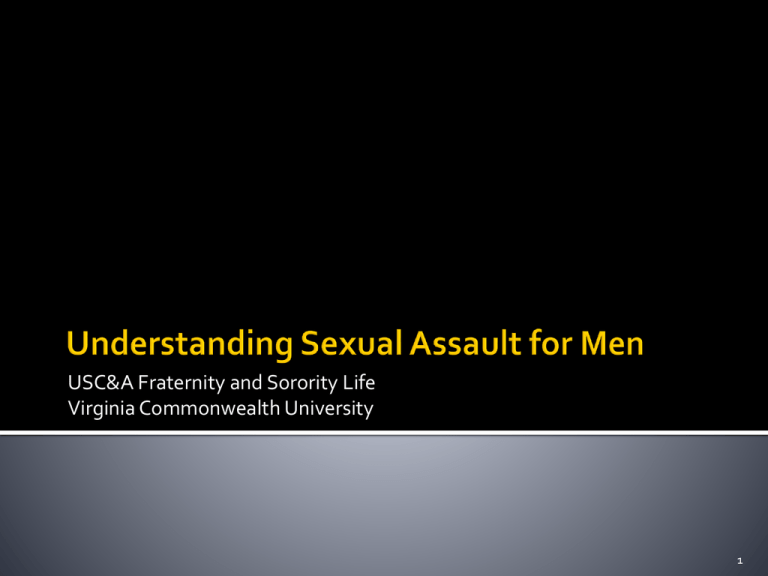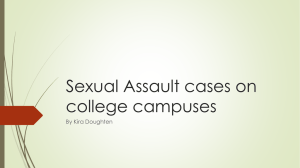
USC&A Fraternity and Sorority Life
Virginia Commonwealth University
1
The purpose of this module is to raise the level
of awareness and education that fraternity men
have on the issues of rape and sexual assault.
2
Myths and Facts
Sexual Assault & Consent
Rape and VCU Policy
What Men Can Do.
Commitment
Resources at VCU
3
Myth #1
Victims provoke sexual
assaults when they dress
provocatively or act in a
promiscuous manner.
4
Fact #1
Rape and sexual assault are crimes of violence and
control that stem from a person's determination to
exercise power over another.
Neither provocative dress nor promiscuous
behavior are invitations for unwanted sexual
activity.
Forcing someone to engage in non-consensual
sexual activity is sexual assault, regardless of the
way that person dresses or acts.
5
Myth #2
It’s not sexual assault if it
happens after drinking or
taking drugs.
6
Fact #2
Many state laws hold that a person who is cognitively
impaired due to the influence of drugs or alcohol is not able
to consent to sexual activity.
Being under the influence of alcohol or drugs is not an
invitation for non-consensual sexual activity.
A person under the influence of drugs or alcohol does not
cause others to assault him/her; others choose to take
advantage of the situation and sexually assault him/her
because he/she is in a vulnerable position.
The act of an offender who deliberately uses alcohol as a
means to subdue someone in order to engage in nonconsensual sexual activity is also criminal.
7
Myth #3
It’s only rape if the
victim puts up a fight
and resists.
8
Fact #3
Many states do not require a victim to resist in order to charge the
offender with rape or sexual assault.
In addition, there are many reasons why a victim of sexual assault
would not fight or resist his/her attacker.
He/She may feel that fighting or resisting will make his/her attacker
angry, resulting in more severe injury.
He/She may not fight or resist as a coping mechanism for dealing
with the trauma of being sexually assaulted.
Many law enforcement experts say that victims should trust their
instincts and intuition and do what they think is most likely to keep
them alive.
Not fighting or resisting an attack does not equal consent.
It may mean it was the best way he/she knew how to protect
himself/herself from further injury.
9
Myth #4
Many women say "No"
when they mean
"Yes."
10
Fact #4
If a woman/man says "No," that "No" must be
respected.
There is no such thing as "the point of no return" or
"not being able to stop."
If at any point a person says "No," you must stop.
If someone tells you to stop, they may be
uncomfortable for a variety of reasons, one of
which might be that they have been assaulted in the
past.
11
Myth #5
If he pays for dinner
and drinks, she
owes him sex.
12
Fact #5
It doesn't matter how much he
spends, sex cannot be expected as a
payback.
13
Myth #6
He/She didn't say no.
14
Fact #6
There are many ways that people say no to sex without
using the word 'no' for examples:
▪
▪
▪
▪
▪
▪
▪
▪
▪
I've got a boyfriend /girlfriend.
Let's just go to sleep.
I'm not sure.
I'd really like to but …
You've been drinking.
I've been drinking.
I want to be alone.
Don't touch me.
I'm not in the mood.
15
Myth #7
A man that is assaulted by
another man is gay.
16
Fact #7
Sexual assault is about power and control.
A man that is assaulted by another man does not
make him gay or any less of a man.
The man needs help and support like any other
survivor of sexual assault.
17
Sexual assault is broadly defined as:
Any physical contact of a sexual
nature without voluntary
CONSENT.
18
Consent is a voluntary, sober,
enthusiastic, wanted, informed,
mutual, honest, and well
communicated agreement.
19
Both partners need to be fully conscious and
aware.
Both partners are equally free to act.
Both partners clearly communicate their
willingness and permission.
The absence of a “No” does not equal consent.
20
"Mental incapacity" means that condition of the
complaining witness existing at the time of an offense under
this article which prevents the complaining witness from
understanding the nature or consequences of the sexual act
involved in such offense and about which the accused knew or
should have known.
"Physical helplessness" means unconsciousness or any other
condition existing at the time of an offense under this article
which otherwise rendered the complaining witness physically
unable to communicate an unwillingness to act and about
which the accused knew or should have known.
21
Defines sexual misconduct as “unwelcome acts of a sexual
nature committed by a student against another student without
consent”
Includes:
Unwelcome touching
Coerced sexual intercourse
Unwelcome sexual propositions, invitations or other pressure for sex
Implied or overt threats of a sexual nature
Making gestures of a sexual nature
Unwelcome sexual remarks about clothing, body, or sexual activities
(including humor/jokes about sex that denigrate women or men in
general)
22
The following constitutes lack of consent:
• Threat
• Force
• Intimidation
• Mental or physical inability to understand the
situation, the consequences of his/her choices or to
express his/her desires
23
On the following slides there will be sentences
with blanks spots.
After each sentence is read, please write down
on a separate sheet of paper the first word that
comes to mind.
Remember to be honest with yourself.
Answers will not be collected.
Do not shout out answers.
24
That guy is a _____
because he can’t get
laid.
25
That girl is such a
______.
26
Watch out for her, she is
such a _______.
27
Look at the way she is
dressed, she must be
______?
28
How easy was that?
What words did you choose?
Are you okay with those choices?
Why do we decide to use these words?
What do these words do?
29
Why do you feel men are blamed?
What should men do to create change?
30
Stop making and/or laughing at degrading jokes
about sexual orientation, sex roles and women.
Challenge abusive behavior when you witness it.
If you see a woman in trouble at a party, don’t be
afraid to intervene.
Never force, pressure or coerce anyone to have
sex.
31
Don’t take silence as consent.
Don’t have sex with someone who is drunk,
passed out, or asleep.
Stop if someone says, "No," is reluctant or is
not clearly consenting.
Don’t assume that someone wants to have sex
because of their reputation or dress.
Stop using abusive language.
32
What are five things that your chapter can
commit to do to create change?
How will all members be informed and
commit to the change?
Examples:
▪ All members will participate in “Take Back the Night.”
▪ Members will refrain from referring to women as sluts.
▪ The chapter will develop a code of conduct.
33
It is not just her issue,
it is everyone’s issue.
We can no longer be
bystanders.
34
Coordinator, Sexual Assault & Domestic
Violence Services (828-2085)
VCU Police (828-1234)
Student Health Services (828-8828)
University Counseling Center (828-6200)
35
Myths and Facts About Sexual Violence, Illinois Coalition Against Sexual Assault,
<http://www.icasa.org/docs/myths_and_facts_from_vawo.pdf >
Greenfeld, Lawrence A., Sex Offenses and Offenders: An Analysis of Data on Rape and Sexual Assault, Washington, DC: U.S.
Department of Justice, Bureau of Justice Statistics (1997).
Bureau of Justice Statistics, Crime Characteristics: Violent Crime - Victim/Offender Relationship (last
revised Dec. 20, 2001) <http://www.ojp.usdoj.gov/bjs/cvict_c.htm>
Fisher, Bonnie S., Francis T. Cullen and Michael G. Turner, The Sexual Victimization of College Women Washington, DC: U.S.
Department of Justice, National Institute of Justice and Bureau of Justice Statistics, NCJ 182369 (December 2000).
Snyder, Howard N., Sexual Assault of Young Children as Reported to Law Enforcement: Victim, Incident, and Offender Characteristics,
Washington, DC: American Statistical Association and U.S. Department of Justice, Bureau of Justice Statistics, NCJ 182990 (July
2000).
Rennison, Callie M., National Crime Victimization Survey, Criminal Victimization 2000: Changes 1999-2000 with Trends 1993-2000,
Washington, DC: U.S. Department of Justice, Bureau of Justice Statistics, NCJ 187007 (June 2001)
Rennison, Callie M., Violent Victimization and Race, 1993-98, Washington, DC: U.S. Department of Justice, Bureau of Justice
Statistics, NCJ 176354 (March 2001)
Greenfeld, Lawrence A. and Steven K. Smith, American Indians and Crime, Washington, DC: U.S. Department of Justice, Bureau of
Justice Statistics, NCJ 173386 (February 1999)
36
For more information or support please contact:
USC&A Fraternity & Sorority Life Office
907 Floyd Ave., Room 014
Richmond, VA 23284
Phone: (804) 828-4685
Email: vcugreeks@vcu.edu
Web: www.usca.vcu.edu/greeklife
37






